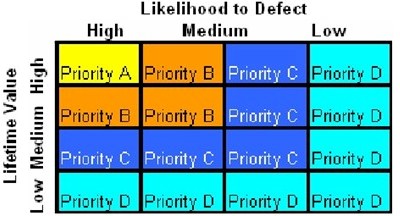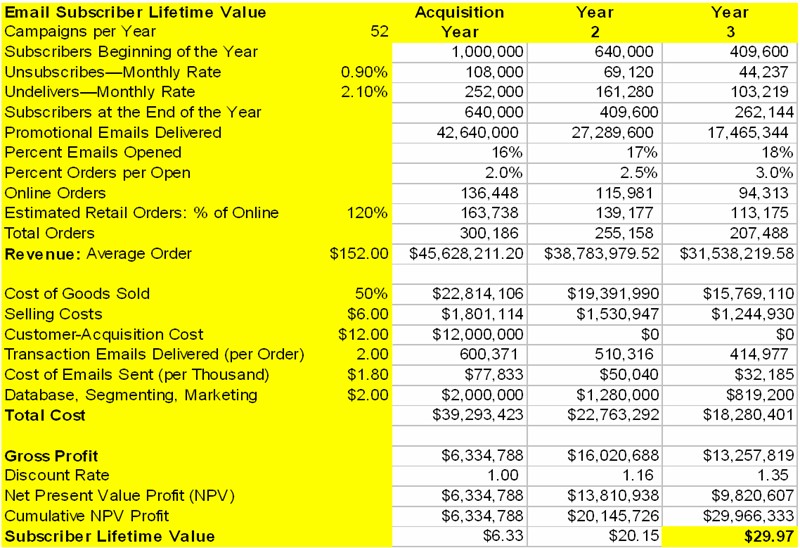Predictive analysis has a long and profitable history with direct mail. Millions of dollars have been saved by focusing on those customers most likely to buy—and not mailing to those who are unlikely to be interested.
Email marketing is a different story. Emails are so cheap to send that the attitude has been "Mail 'em all. It costs peanuts to blast the entire list." Accordingly, predictive-modeling analysts have been shut out of most email-marketing operations. That is beginning to change.
The reason? Inbox clutter. Every corporation in America is now sending emails to the same US online households. Billions are sent daily. Consumers cannot handle it all. Open rates are falling—average rates are less than 15% today. That means 85% of legitimate commercial emails never get opened or read by anybody. Millions of consumers are unsubscribing from emails that they had recently signed up for.
If marketers want to keep their subscribers, they had better make sure that what they send is content that their subscribers are really interested in. Send too many irrelevant emails, and subscribers will unsubscribe. You will have lost them forever. Many marketers are losing more than one million or more subscribers per year. That is a significant loss, considering that a typical email subscriber is worth $20 or more in long-term profits.
How can predictive analytics help? In two ways: First, segment your subscribers, and develop emails designed specifically for each segment; second, use analytics to predict which subscribers are most likely to unsubscribe, and—if those subscribers are valuable—find a way to keep them.
In our talk at the Predictive Analytics World conference last February in San Francisco, Anna Lu—director of research and analytics at e-Dialog—and I explained the email world to a room full of card-carrying predictive modelers. When we began, the room was half full. At the end of the hour, all seats were filled and lots of analysts were standing around the sides of the room. What was the excitement?
We began with a simple example using Next Best Product (NBP) analysis. In this example, a marketer with 2.5 million subscribers selected 273,334 among them who would be most likely to respond to the offer of a particular product. Those subscribers were sent an email featuring that product. To be sure that the NBP modeling had been done correctly, a control group of 20,000 was randomly selected to receive the same mailing. Here is what the example demonstrated:

An email to the specially targeted 273,334 subscribers resulted in 842 sales (0.31%) and 273 unsubscribes (0.10%). Emailing the randomly selected 20,000 subscribers resulted in three sales (0.02%)—and generated a whopping 260 unsubscribes (1.3%). Why? Because sending emails to people who are not interested in what you are selling leads them to unsubscribe. Once they are gone, they are gone. You have lost the chance to sell them something that they would be interested in. The danger in the random select is shown by the last row in this example. If 273,334 subscribers had been selected by a random select and sent the same email as the first group, a total of 3,553 might have unsubscribed—if we apply the unsubscribe rate of the 20,000 control group.
Conclusion: Using analytics can help email marketers reduce the unsubscribe rate—crucial to maintaining a responsive audience in the email-marketing world.
Predicting the Unsubscribers
Predictive analytics has a long and successful history in credit cards and cell phones because of its ability to identify those customers most likely to churn (switch to a rival cell-phone or credit-card provider). Today it can be used to predict the most vulnerable email subscribers of companies selling products.
First, demographics and behavior data are added to the email-subscriber base. Then calculations are made to determine the two major types of customer: the most valuable subscribers, by figuring out lifetime value; and those most likely to leave, by using multiple regressions.
Email-Subscriber-Lifetime-Value Calculation
Email-subscriber-lifetime-value calculation is becoming routine for advanced email-service providers (ESPs), which develop tables like the following:
One million subscribers are studied over a three-year period. Their average lifetime value is $29.97. Those findings can be applied to each of the 1 million subscribers to determine a value for each subscriber.
Churn Likelihood
Either of two statistical methods, Chi-squared Automatic Interaction Detector or multiple regressions, can be used together with the subscriber lifetime value to create an attrition score for each of the 1 million subscribers. By using these two numbers (churn likelihood and lifetime value), email marketers can create a risk revenue matrix that looks like this:

Once an email marketer has created such a chart, it is simply a matter of focusing on subscribers in Priorities A and B and making them offers that will keep them from unsubscribing. You do not need to worry about subscribers in Priorities C and D. They are either very loyal (they will never leave) or they are of very low value (it doesn't matter if they leave).
* * *
Today, we are just beginning to use predictive analysis for email marketing. Those who understand it and how it can be applied to email marketing will be the winners as the email-marketing industry gets into high gear.
Check out SmartTools: Email Campaign Planner for more help in building winning email campaigns. As a Premium Member, you have free access to this tool and hundreds of Premium articles, case studies, templates, research, SmartTools and "how-to" guides to help you rapidly build effective marketing programs.




